Finding Family in The Times of India’s Mid-Century Kodak Ads
Skip other details (including permanent urls, DOI, citation information)
: This work is licensed under a Creative Commons Attribution-NonCommercial-NoDerivatives 4.0 International License. Please contact [email protected] to use this work in a way not covered by the license.
For more information, read Michigan Publishing's access and usage policy.
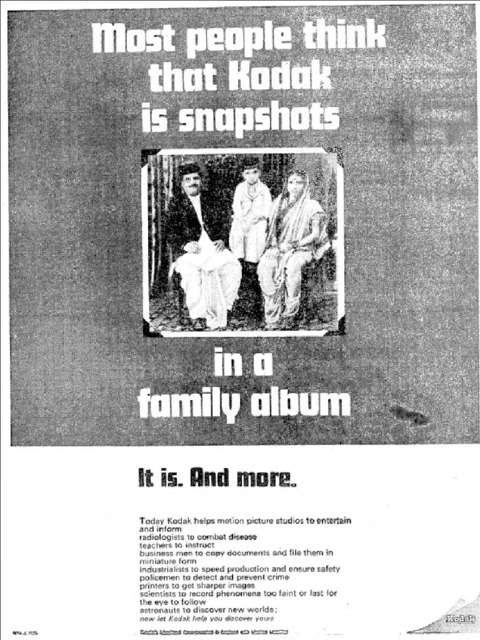 Fig. 1. Hindustan Thompson Associates & Kodak Ltd., “Most people think that Kodak is snapshots in a family album,” The Times of India, 28 September 1969, pg. 10, courtesy of Eastman Kodak Company.
Fig. 1. Hindustan Thompson Associates & Kodak Ltd., “Most people think that Kodak is snapshots in a family album,” The Times of India, 28 September 1969, pg. 10, courtesy of Eastman Kodak Company.On September 28, 1969, almost eighty years after the Eastman Kodak Company was founded in the United States and a little more than fifty after Kodak Limited was established in Mumbai (then Bombay), the company ran an ad in The Times of India asserting its foothold in the public consciousness as the brand for documenting, representing, and preserving family stories (figure 1).[1] The black-and-white ad claims confidently, “Most people think that Kodak is snapshots in a family album,” and features an image of a photograph that is secured to an album page with black photo corners. The photograph has the white border and square dimensions of a typical modern print made with Kodak film, which dealers at the time sold in cities such as Mumbai, Kolkata (then Calcutta), Delhi, and Chennai (then Madras).[2] Perfectly centered within the frame are a man, a woman, and a child wearing mixed traditional and modern Indian formalwear — a family, as the ad copy suggests — who appear to be positioned on a patterned rug in front of long, loosely arranged draperies and possibly architectural elements. All three subjects look directly at the photographer with neutral countenances. They are painstakingly posed in a manner that conjures visions of late-nineteenth- to early-twentieth-century studio portraiture, rather than of a candid, domestic scene, which so epitomized mid-century Kodak ads. Below this image, there is black text against a white background that boldly states, “It is [snapshots in an album]. And more.”
To stake the brand’s claim beyond the limits of family photography, the copy lists many additional uses for Kodak products in diverse fields such as entertainment, health, education, business, industry, law enforcement, and science.[3] The text concludes that astronauts use Kodak “to discover new worlds” and then incites the reader to purchase its products by stating: “[N]ow let Kodak help you discover yours.” Juxtaposed with this message, the use of an image of a family photograph — which in its composition is arguably not modern but is printed using contemporary methods — frames the genre as an enduring, albeit old-fashioned, mainstay of contemporary Indian life. In the bottom corner of the ad, the company name appears as if from behind a turning page, a graphic design that although a staple of Western Kodak advertisements, in this context could further signify a “turning of the page” in the history of the company’s marketing strategies in India. Here, Kodak aligns its brand with technological advancement, innovation, and professional aspiration, veering from its identity as a manufacturer of predominantly familial or domestic photographic products. More can be said about how and why this ad draws on visual and linguistic codes of past, present, and future to appeal to professionals and leaders of industry within India at this time; however, it is the allusion to a widespread cultural practice of snapshot photography in everyday family life that is of primary interest here. The ad suggests popular associations between the brand and family photography, belying the company’s significant visual and discursive work of the preceding decades that sought to make this so.
As many scholars have noted, photography arrived in India shortly after its invention, in 1839, and though it was taken up by both Western and Indian amateur and professional photographers for diverse aims, it served as a powerful tool for British colonialist and imperialist agendas, as well as commercial enterprises, which produced images that exoticized India’s inhabitants and landscapes to meet a growing demand in the West for picturesque photographs of British colonies.[4] These scholars have shown how early photography in India was a cumbersome and highly technical process and how its practice was deeply entrenched in interrelated colonialism, empire building, and ethnographic projects. Furthermore, early photography, such as that practiced in the studio, was accessible mainly to Western consumers and wealthy Indian clientele.[5] This is a far cry from the idea of ubiquitous “snapshots in a family album” in Indian households. Thus, although the ad shows Kodak “turning over a new leaf,” it is essential first to understand the visual and discursive strategies of the preceding decades that sought to give the brand and the concept of the family snapshot relevance and meaning in Indian society.
To consider what Kodak ads can reveal about the development of family photography in India, this article examines a selection of them published in The Times of India from the late nineteenth century, when the company’s cameras arrived at photo-supply shops in Indian cities, to 1979, the year when Kodak changed its name to India Photographic Company Limited. It explores these questions: What strategies did Kodak use to embed its brand and its technology into the existing discourses, institutions, and cultural practices in India?[6] What subjects and institutions did the company create to promote the use of its products in daily family life? How did Kodak try to shape representations of family and how were the ads, and later the company, themselves shaped by colonial and postcolonial discourses in India?
By locating representations of family and domesticity within Kodak ads in The Times of India, this article identifies the emergence of the visual trope of the Indian nuclear family and the introduction of a new role, that of the modern Indian “father-photographer.” It argues that whereas early-twentieth-century ads represented the country, its people, leisure, and family life through the colonialist lens of the Western Kodak Girl, many of the mid-century ads represented Indian families in everyday domestic scenes captured by a father figure’s lens. In these mid-century ads, Kodak marketed snapshot photography as a shared cultural practice among Indian middle-class, nuclear families by representing everyday moments, significant events, pastimes, and holidays enjoyed by Indian consumers.[7] More broadly, this article investigates one strategy for introducing roll-film cameras in India — Kodak print ads — and considers how the evolution of these ads show the transnational company adapting its marketing approaches in response to political, economic, and cultural developments, both within India and abroad.[8]
Connections to Existing Literature
This study considers Kodak’s place in the greater histories of family photography in India, many of which, as Deepali Dewan writes, have yet to be told.[9] For example, there has been significant research on early ethnographic and colonial photography, as well as on professional photo studios in the late nineteenth and twentieth centuries, but less on the everyday production of family photography in South Asia.[10] The art historian Vidya Dehejia notes that two decades after its introduction, in 1888, the easy-to-use Kodak box camera — often credited for democratizing photography by simplifying its processes to the click of a button — was widely available, transforming it from an activity requiring specialized skill to “a social pastime closely associated with family life.”[11] Yet there is much more to explore in terms of how photography was conceptualized as a family pastime in India — a process in which Kodak played but one part, albeit arguably a significant one.
The economic sociologists Munir and Phillips have examined the rise of Kodak in the United States, and the strategies used by the company to surmount its early challenges, among them failing to meet the standards of serious amateur and professional photographers and to appeal to mass consumers who had yet to think about snapshot photography as a part of ordinary life.[12] They hold that to achieve its fame as a household product, Kodak had to change mainstream ideas of photography, to embed its technology into existing cultural practices and institutions, and to create new subject positions or roles in relation to its photographic products.[13] Through discursive strategies, they argue that “Kodak Moments” entered into popular consciousness and the practice of family photography was promoted as an essential part of American life.[14] Munir and Phillips’s investigation offers a useful framework for thinking about Kodak’s presence in India when expanded to consider photography’s colonial past; the global movement of commodities; the country’s evolving political, social, and economic climate; and the shifting opportunities and challenges for multinational companies in India.[15]
An exploration of how Kodak branded its products as a part of daily life engages with further areas of research, such as the histories of small-scale technologies and the history of advertising in India. For example, the historian David Arnold has studied how small machines had a profound social, economic, and cultural impact on Indian society between the 1880s and the 1960s.[16] He makes references to the camera as one of many “modernizing goods”[17] that came to India from the West, and was marketed to, and appropriated by, local consumers, but he does not include it as a key case study, thus inviting questions about how roll-film cameras were embraced as an “everyday technology” in Indian households. In addition, although several scholars have examined the significant cultural and social impact of Kodak advertising in the West, their work doesn’t extend to the South Asian context.[18] There is also growing body of research that examines the advertising of domestic commodities and pastimes, such as teas, tonics, home decor, and entertainment, in the subcontinent, but none focuses on cameras for the family.[19] However, the existing studies on advertising in South Asia are hugely instructive, particularly in relation to the complexities of the term “middle class”; the history of advertising and global capitalism in the subcontinent; the use of shifting visual strategies to appeal to Indian consumers in a postcolonial climate; representations of family, home, gender, and race in advertising; and the rise of a “domestic economy” in the early twentieth century.[20]
Historical Context: India’s Independence and The Times of India
Before offering an analysis of the Kodak advertisements, it is important to address briefly the historical context in which they were published, particularly the history of India’s independence and The Times of India. Between the late nineteenth century and 1979, the country experienced sweeping social and political change. It transformed from a colony of the British Empire to, in 1947, an independent nation, which divided the land and forcefully displaced many of its people into what became India and Pakistan.[21] January 26, 1950, a date that is celebrated annually as Republic Day, marks the occasion when India’s constitution was enacted, thus making it a republic and, two years later, resulting in India’s first government election.[22] Driving this political change was ongoing resistance from Indian capitalists, educated Indians, and nationalists, which had reached a critical point after India’s support of British efforts during World War II.[23] Underpinning these changes were an ever-varied and in-flux embrace of the swadeshi movement, which promoted Indian-made goods; political and economic discourses of nationalism and independence; different degrees of consumer desire for, anxieties about, and ability to purchase Western commodities; and state-imposed restrictions on the import of foreign goods.[24] These social, political, and economic circumstances had a profound impact on global capitalism, industry, transnational advertising, and consumption patterns, which were central to the development of Kodak in India.
The Indian press during this time comprised both English-language papers, published out of urban centers, and vernacular papers in regional languages.[25] The ads discussed in this article were accessed through an online archive for The Times of India (henceforth, “the Times”).[26] The Times is an English-language newspaper that was established in 1838 as The Bombay Times and Journal of Commerce.[27] It was printed in large cities such as Mumbai and Delhi for a readership of wealthy British expats and possibly members of the Indian upper class.[28] By 1861, the publication had adopted its current name; however, the audience it wrote for remained the same. Haynes has noted that between 1914 and 1940, Times readers were still primarily “Europeans and perhaps [. . .] those seeking to emulate Europeans more closely.”[29] However, after India’s independence (1947), it appears that the paper’s content evolved to be more representative of the country’s social context and political climate. The Times became one of its leading newspapers and today is part of The Times Group, a mass-media organization.[30]
When thinking about the changing nature of Kodak ads in the Times between the late nineteenth century and 1979, it is important to consider the shifting historical context of colonialism, rising nationalism, and independence, which transformed both the newspaper and its readership and, consequently, the ads it printed. It must be stated, too, that this paper examines Kodak’s ad strategies in a publication whose readership was in different periods variously circumscribed by such factors as class and race. Also, although the Times ads reveal how Kodak came to represent Indian middle-class families, they offer little insight into actual consumption patterns, economic realities, or diverse kinship structures of those households.[31]
Early ads for Kodak (1890s–1910s)
Before 1890, photography had already played a significant role in visualizing and substantiating colonial and imperial discourse in the subcontinent.[32] For example, from 1863 to 1870, the expedition photographer Samuel Bourne had produced widely circulated commercial photographs that exoticized the country and its people, and photography had been used in administrative and ethnographic projects, such as The People of India (1868–75), to produce colonialist knowledge of and discourse about India.[33] In addition, the late nineteenth century had seen the proliferation of British- and Indian-owned photography studios, as well as photographic societies in urban centers.[34] In this context, even though photography as a professional and colonial practice was well established, there was much work to be done to forge a place for amateur photographic products, such as George Eastman’s easy-to-use box camera of 1888; make the low-quality roll-film cameras desirable to users; and associate the Kodak brand with family and domesticity.
 Fig. 2. J. Neuberg Photographic Goods, “J. Neuberg Photographic Goods,” The Times of India, 15 April 1890, pg. 1.
Fig. 2. J. Neuberg Photographic Goods, “J. Neuberg Photographic Goods,” The Times of India, 15 April 1890, pg. 1.The earliest advertisements for Kodak products in the Times appeared in late-nineteenth-century were commissioned by stores to announce the arrival of commodities from abroad.[35] One example is an 1890 ad for J. Neuberg’s Photographic Goods, a shop located on Medows Street in Mumbai (and later Esplanade Road), which sold a variety of items produced by such manufacturers as Acme, Illford, Meagher’s, and Wood’s (figure. 2). Here, “Kodak Cameras” and spools are listed alphabetically with lamps, lenses, plates, tripods, chemicals, papers, and developing tools. The ad informs readers that the goods arrived on the ships from the P & O Steam Navigation company, the only steamers running between England and India.[36] It offers very little information about the products, other than their availability and a promise that “quality and freshness are guaranteed,” which was critical for photographers working in tropical climates.[37]
J. Neuberg’s Times ad is revelatory of the types of consumers to whom nineteenth-century shop owners appealed in their print ads for English-language papers. Based on the products available, these consumers were primarily amateur or professional photographers with the specialized skills and expertise to use them. However, the addition of Kodak cameras and spools, as well as a Guide Book for Beginners, also indicates the availability of products for individuals with a burgeoning interest in photography —considering the late-nineteenth-century readership of the paper, likely members of the British or the English-speaking-Indian upper classes.[38]
This 1890 ad is also indicative of Kodak’s fledgling presence in England and its colonies at the time. George Eastman’s first Kodak roll-film camera had been invented only two years earlier and the United States–based Eastman Kodak Company did not set up its British manufacturing plant until 1891, followed five years later by its British subsidiary, Kodak Ltd.[39] An article in a prominent English photography journal entitled “Photography in India” (1897) helps to illustrate that among British photographers traveling to India, roll film (as was used in the Kodak cameras) was still not considered an asset to the serious photographer, for the most part the result of environmental factors, despite the challenges posed by using glass plates in India’s hot and damp climate or by restrictions on the circulation of photographic chemicals.[40] The author of the article advises that “glass plates are much preferable to films in hot climates” and that the photographer should pack only a camera produced by a reliable brand (Kodak is not among those listed), as well as the plates needed for the trip. The article goes on to describe in detail how one might set up a darkroom in a bungalow or hotel bathroom, as well as where to buy the needed products in Mumbai — Neuberg is mentioned. Thus, it is apparent that although Kodak cameras had arrived in Britain and in India, the company had yet to become, or even present itself as, a leader in local or global photographic markets. In early ads, we see glimmers of snapshot photography as a transnational cultural practice through the availability of the Kodak cameras in Mumbai’s shops, but there is no evidence of photography being framed as a family activity.
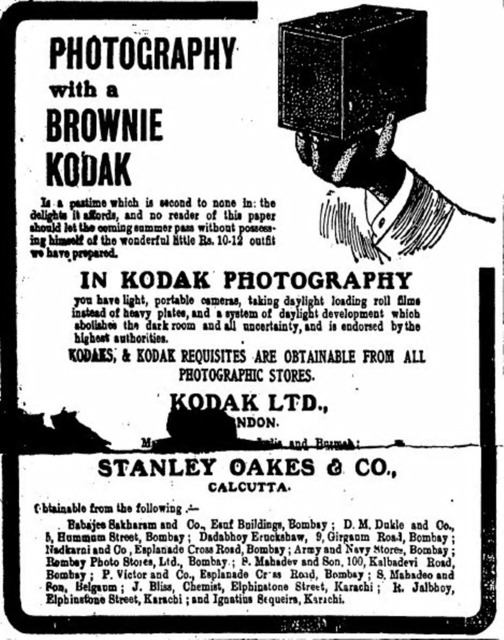 Fig. 3. Kodak Ltd., “Photography with a Brownie Camera,” The Times of India, 24 January 1910, pg. 16, courtesy of Eastman Kodak Company.
Fig. 3. Kodak Ltd., “Photography with a Brownie Camera,” The Times of India, 24 January 1910, pg. 16, courtesy of Eastman Kodak Company.In the decades that followed, Kodak Ltd. began to produce its own promotions, as with a 1910 ad for the Brownie Camera (Fig. 3).[41] In comparison to the J. Neuberg ad, here Kodak resituates its product and sets apart its brand by stressing its simplicity and portability, which, as many scholars have noted, was a critical marketing strategy for the company.[42] The ad copy refers to photography with a Brownie as a delightful “pastime” and boasts its use of light roll-film instead of “heavy plates.” It appealed to consumers who may not have wanted to go through the effort of setting up a darkroom by explicitly stating that it “abolishes” this step. The ad does not mention “family” or specific domestic events at which one might want to have a camera, but it does refer to the need for a camera during the “coming summer,” suggesting its use in leisure activities and for tourists. It then states that Kodak cameras are available at all photographic stores by highlighting the product name and listing the stores in fine print: interestingly, in the inverse of the J. Neuberg ad, which foregrounded the store name and put the products in fine print. Shortly after, in the decades following 1913, Kodak Ltd. began to establish its own shops, ones that sold the company’s products exclusively: Kodak Ltd., at 109 Esplanade Road, Mumbai; Kodak House, on Hornby Road, Mumbai; and Kodak dealerships in Kolkata, Delhi, and Chennai, as well as in Lahore and Karachi.[43]
The Kodak Girl in India: Kodak ads from the 1920s to 1947
By the 1920s, Kodak had begun to incorporate illustrations in its ads, not only inspired by marketing strategies used in the West, but also representing India in a way that reproduced British colonialist aesthetics and attitudes. A central figure in the ads was the infamous Kodak Girl, who could be seen enjoying the subcontinent’s sights and scenery, appealing to Western travelers and consumers of tourist imagery. The Kodak Girl, a company icon first developed in the United States in 1892, embodied the spirit of adventure, fashion, beauty, independence, and youthfulness.[44] Often wearing a pretty striped dress, the Kodak Girl was featured in marketing campaigns in both photos and in illustrations. The models may have changed, but in the early-twentieth-century ads, this character was consistently a young, attractive, white woman.[45] Designed to be a paragon of modern Western womanhood, the Kodak Girl was often shown in the midst of an adventure “unencumbered by heavy equipment or a male companion.”[46] For more than eight decades, she was seen in countless ads enjoying travel, leisure, and sports, and later, as the visual and cultural historian Nancy Martha West notes, observing outdoor domestic scenes to suggest her future domesticity.[47] Although West suggests that it was rare to see the Western Kodak Girl in countries other than in Europe, presumably in ads and publications published in the United States, the Times proves that at least in the English-language press in 1920s India, she was an ever-present force for the company’s UK subsidiary.[48] In the Times ads, the Kodak Girl and her companions explore the country largely unburdened by any sense of obligation, whether familial or domestic, and disconnected from social or political tension that a British traveler might cause or encounter in colonial India.[49] Indeed, she seems to observe Indian street and village life without drawing attention to herself, as if her presence were as natural a part of the landscape as are the subjects of her gaze.
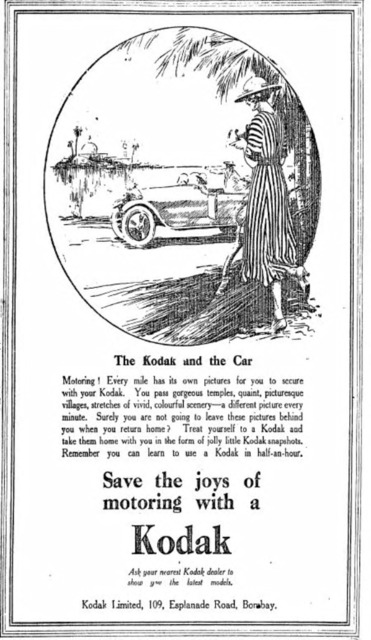 Fig. 4. Kodak Ltd., “The Kodak and the Car,” The Times of India, 14 December 1922, pg. 12, courtesy of Eastman Kodak Company.
Fig. 4. Kodak Ltd., “The Kodak and the Car,” The Times of India, 14 December 1922, pg. 12, courtesy of Eastman Kodak Company.Not only did the figure of the Kodak Girl fit into preexisting British colonialist picturesque traditions that situated well-dressed Englishwomen within Indian landscapes in attempts to feminize and neutralize representations of the nation’s conflicted social and political terrain, but also the compositions of the ads drew on other aspects of colonial pictorial logic to appeal to Western consumers.[50] For example, in the Times, the Kodak Girl was sometimes one of a foursome motoring across the South Asian countryside. One ad, from 1922, shows the Kodak Girl in the foreground, standing with her camera in the shade of a tree. She takes a snapshot of a domed architectural ruin surrounded by foliage and water in the distance, as her friends point to the building from an automobile (figure 4). The copy associates Kodak with the concept of the holiday daytrip and promises the opportunity to compose picturesque images: “You pass gorgeous temples, quaint, picturesque villages, stretches of vivid, colourful scenery — a different picture every minute.” It tells consumers to save their memories with Kodak and to take their pictures home with them, further underscoring the identity of the reader as a tourist. Here, the Kodak Girl composes her snapshot using techniques established by Bourne and others for capturing a picturesque image, which as outlined by the scholar James R. Ryan contains “an expanse of water with many reflections, [. . .] foliage in the foreground, allowing for the play of light and shade, and a carefully posed figure to draw the viewer’s gaze,” as well as sites of architectural interest.[51] This ad takes advantage of the earlier consumer desire for colonialist picturesque images, which had been notoriously difficult for photographers such as Bourne to capture, requiring time, physical exertion, labor, equipment, and skill,[52] by illustrating how tourists could quickly and easily compose their own shots. It reflects what Jodi Throckmorton describes as an early colonialist demand, both in India and abroad, for images of the country that portray it as a “foreign and ‘exotic’ land,”[53] and at the same time use scenic elements to associate travel photography with nostalgia, pleasure, and comfort.
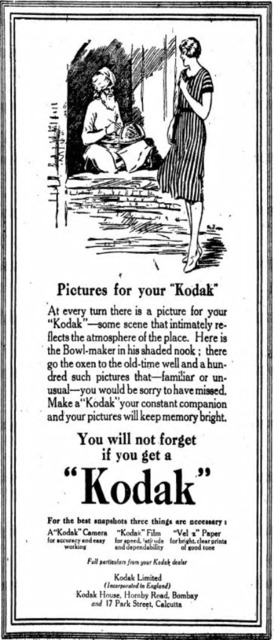 Fig. 5. Kodak Ltd., “Pictures for your Kodak,” The Times of India, 22 November 1926, pg. 18, courtesy of Eastman Kodak Company.
Fig. 5. Kodak Ltd., “Pictures for your Kodak,” The Times of India, 22 November 1926, pg. 18, courtesy of Eastman Kodak Company.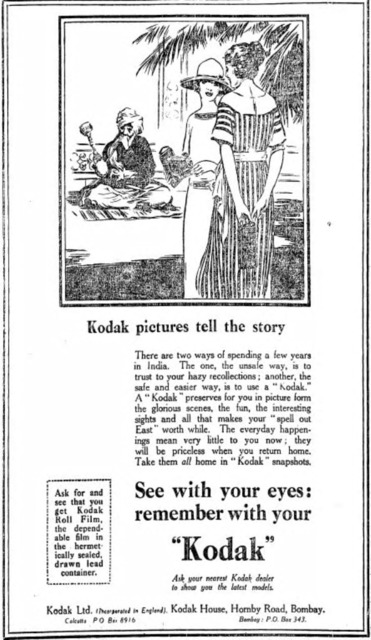 Fig. 6. Kodak Ltd., “Kodak Pictures Tell the Story,” The Times of India, 26 January 1925, pg. 16, courtesy of Eastman Kodak Company.
Fig. 6. Kodak Ltd., “Kodak Pictures Tell the Story,” The Times of India, 26 January 1925, pg. 16, courtesy of Eastman Kodak Company.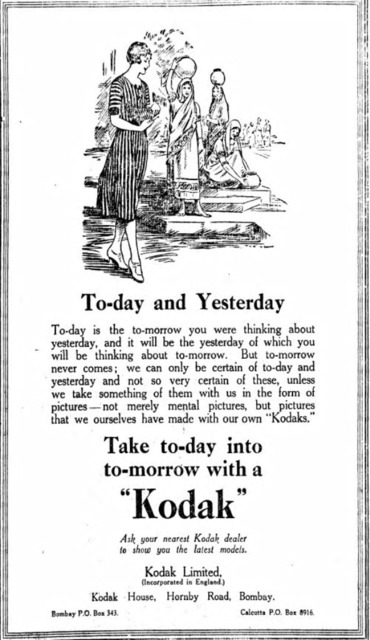 Fig. 7. Kodak Ltd., “To-day and Yesterday,” The Times of India, 9 November 1925, pg. 16, courtesy of Eastman Kodak Company.
Fig. 7. Kodak Ltd., “To-day and Yesterday,” The Times of India, 9 November 1925, pg. 16, courtesy of Eastman Kodak Company.In their representations of Indian people, Kodak Girl ads also drew on colonialist traditions that presented Indians as exoticized or essentialized tropes intended to delight Western viewers, highlight difference, mask racial tensions, and naturalize colonial power and presence in India.[54] In one ad, the Kodak Girl encounters a bearded craftsman who wears a turban and sits cross-legged at the entrance of a darkened doorway (figure 5). In another, she interacts with a fellow tourist near a man smoking a hookah (figure 6). In a third (figure 7), the Kodak Girl poses with her camera and is juxtaposed with a group of Indian women who wear saris and hold clay pots (matkas) on their heads, reminiscent of a common colonial ethnographic trope, as they dutifully accomplish domestic tasks.[55] All three ads also speak to a Western traveler enjoying “a spell out East” and stress the importance of taking photographs to preserve the “glorious scenes [. . .] and the interesting sights.” Here, the discursive strategy equates Kodak snapshots with souvenirs: they are “priceless” mementos that will serve travelers far better than “mental pictures.” The copy in all three ads frames India’s people and its landscapes as objects to be consumed and disavows the potential for social tension that could arise from photographic encounters in the colonial context.[56] Significantly, there is no interaction between the Kodak Girl and the Indian subjects. Akin to the colonialist discursive and picturesque traditions, the Indian subjects are presented as “docile and unthreatening,”[57] which in the context of the ads suggests their suitability as photographic subjects for Western tourists.
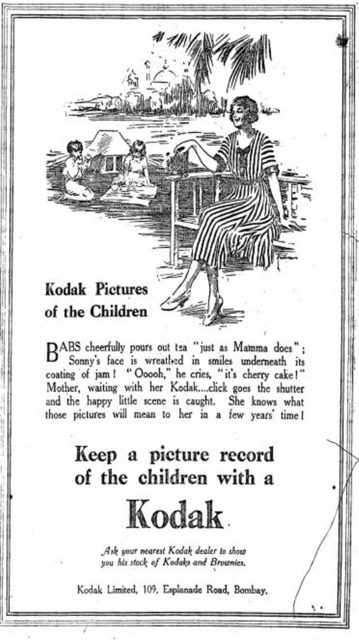 Fig. 8. Kodak Ltd., “Kodak Pictures of the Children,” The Times of India, 7 December 1922, pg. 14, courtesy of Eastman Kodak Company.
Fig. 8. Kodak Ltd., “Kodak Pictures of the Children,” The Times of India, 7 December 1922, pg. 14, courtesy of Eastman Kodak Company.The ads discussed thus far did not target families, least of all Indian families; rather, they were created to sell cameras to British expats and Western tourists who read the Times while in India, and who planned to return home with stories and snapshots in hand. However, the 1920s Kodak Girl ads in the Times did not omit family altogether. In fact, there are some visual representations of the family unit — albeit white, Western families visiting India (figure. 8). For example, in one ad, with the slogan “Kodak Pictures of the Children,” the Kodak Girl watches over two children who enjoy a tea party in the distance. She is, as we are told, “Mother, waiting with her Kodak.” Behind the children is a white canvas safari tent with an outstretched fly, which is likely their holiday lodging, and farther in the distance is a loosely rendered line drawing of a Mughal-style building. In this imagery, the Indian landscape shifts from being the main subject of the tourist camera to the background setting of the Western family’s domestic, outdoor moment. The copy highlights “the happy little scene” of children at play as the new subject of the camera, held by the Kodak Girl, and the enduring affective role of mother. Here, Kodak uses colonialist pictorial and discursive conventions to domesticate a potentially unfamiliar outdoor environment and uses the figure of the mother to conjure ideas of home.[58] Through image and copy, Kodak links the brand to both colonialist experiences of the country and familial experiences of photography as a way to embed snapshots in the Western cultural practice of family holiday abroad. Thus, the 1920s ads help to identify a time during which Kodak began to promote the concept of “snapshots in a family album” but not yet in a way that was meant to appeal directly to Indian consumers.
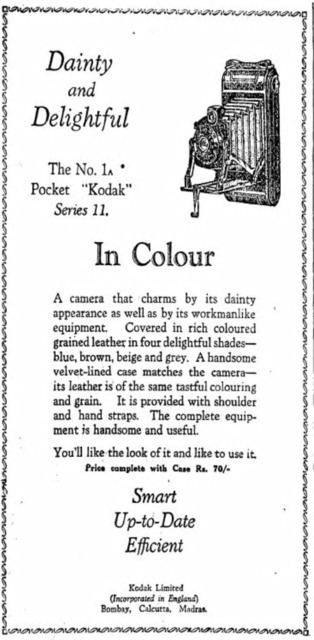 Fig. 9. Kodak Ltd., “Dainty and Delightful,” The Times of India, 11 January 1930, pg. 4, courtesy of Eastman Kodak Company.
Fig. 9. Kodak Ltd., “Dainty and Delightful,” The Times of India, 11 January 1930, pg. 4, courtesy of Eastman Kodak Company.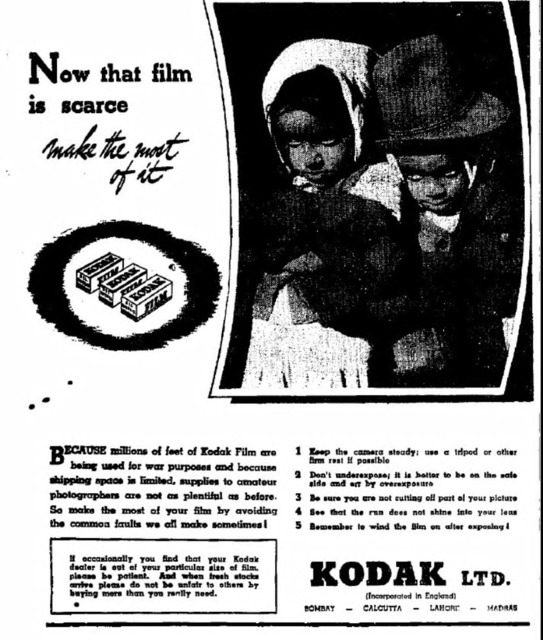 Fig. 10. Kodak Ltd., “Now that film is scarce make the most of it,” The Times of India, 21 December 1942, pg. 10, courtesy of Eastman Kodak Company.
Fig. 10. Kodak Ltd., “Now that film is scarce make the most of it,” The Times of India, 21 December 1942, pg. 10, courtesy of Eastman Kodak Company.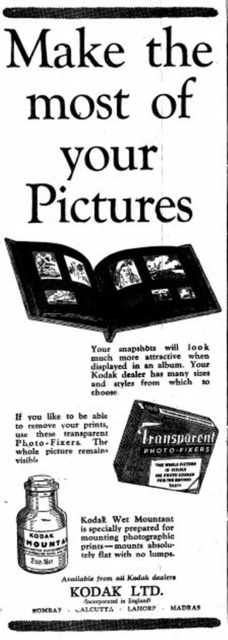 Fig. 11. Kodak Ltd., “Make the most of your Pictures,” The Times of India, 1 November 1946, pg. 3, courtesy of Eastman Kodak Company.
Fig. 11. Kodak Ltd., “Make the most of your Pictures,” The Times of India, 1 November 1946, pg. 3, courtesy of Eastman Kodak Company.By the end of the 1920s, Western Kodak Girl ads appear to wane; however, in the 1930s, Kodak continued to stress the relationship between the brand and concepts of femininity, with ads for products such as the “dainty and delightful” Pocket “Kodak” (figure 9). In the 1940s, this was followed by an abrupt change of strategy, as marketing focused on the use of Kodak technology in the war efforts.[59] During this time, Kodak used advertising to address consumer concerns regarding the limited supply of cameras and film in India; the issue of supply affected a wide range of manufacturers of foreign goods and consumers.[60] The ads plead with customers to be patient, make do with their current cameras, and take the best pictures they can with the film they have. For example, in one ad from 1942, there is a snapshot with two children, bundled up and huddled together, with dour expressions, presumably to indicate an impoverishment of luxury or resources (figure 10). The slogan: “Now that film is scarce, make the most of it.” It explains that amateur photographers are not able to buy the film they need as “millions of feet of Kodak Film are being used for war purposes,” and then offers tips to ensure quality exposures.
Shortly after the end of the Second World War, Kodak ads hinted that an era of limited consumption was starting to change in favor of the consumer.[61] By the late 1940s, Kodak ran ads with promises — “Your Kodak may soon be on your dealer’s counter” — but with caveats such as “Supplies are not yet unlimited.”[62] Other ads stressed the importance of photographic preservation, using the slogan “Make the Most of Your Pictures.” For example, one ad from 1946 shows an illustration of a black-paged album open to reveal several snapshots (figure 11). Although these early postwar ads began to establish ideas of a larger cultural practice of collecting and preserving photos in albums, the illustrations represent Kodak commodities — cameras, photo-fixers, albums, and papers — not families, possibly indicating uncertainty on the part of the company about whom to represent, or whom to appeal to, during the tumultuous years leading up to India’s independence. However, in the 1950s, this would change again, as Kodak adjusted to a new marketing environment emerging in post-independence India.
Snapshots for Indian Families: Post-Independence Kodak Ads (1947–64)
The decades after the end of World War II and the decolonization of India saw significant social, political, and economic transformation, and this considerably altered the visual and discursive character of the Kodak ads in the Times. The year 1947 brought India’s independence, which officially terminated colonial rule, as well as the Partition, which drew new borders between India and Pakistan and displaced hundreds of thousands of inhabitants. The economic historian Tirthankar Roy writes that these events brought “immediate economic and human crises” to the country, followed by new development strategies, such as economic nationalism and industrialization under the first prime minister, Jawaharlal Nehru, who served as the leader of independent India from 1947 to 1964.[63] Nehru had been a leader in the earlier independence movement, and as prime minister, his foreign policy was inspired by anticolonialism and, later, nonalignment, and his government aspired to “democracy, socialism, unity, and secularism.”[64] Roy notes that during this time, India experienced both “acute rural poverty and robust industrialization” and relied on foreign aid.[65] The scholars Jodhka and Prakash talk about the importance of the growing “Nehruvian middle class” to nation-building, democracy, and development during this time.[66] In this context, Kodak would have experienced intense pressure as a multinational company facing changing government policies that prioritized domestic increased nationalism, modernization, and development, and would have to adapt to the postcolonial context to retain consumers.[67] And yet shaping and visualizing concepts of modern, middle-class life, an important social and political project during Nehru’s term,[68] was central to Kodak marketing, and it was a powerful trope that was taken up and adapted in ads produced during this period.
The transfer of political power from British colonialists to middle-class Indian leadership can be seen in mid-century Kodak ads.[69] In post-independence India, the Times Kodak ads no longer spoke to a colonialist consumer base who were enjoying leisure and travel in the subcontinent, though its tourism industry continued to develop into the twenty-first century. Rather, mid-century ads sought to embed the use of the roll-film camera in local customs and family holidays, highlighting the use of cameras in the domestic lives of modern Indian nuclear families. These adaptations are revelatory of shifts in the company’s perceptions of its consumer base, as well as of what kinds of ads were appropriate to run in the Times after India’s independence. Kodak ads of the 1950s also help to illustrate that by this time, the expectation that multinational businesses and agencies would produce ads that reflected and appealed to the local people, values, and customs was firmly established.[70] As Haynes writes, in the preceding decades, ad firms and companies started to conduct research in local communities and hired Indian staff, representing the “formal” and “informal” channels through which ad campaigns may have been influenced.[71] Kodak had a longstanding corporate culture of inviting staff to suggest marketing ideas in the West, and in the subcontinent it hired local employees[72] — and so it is possible that the 1950s ads reflect some of these transcultural encounters, in addition to responses to widespread nationalist expectations.
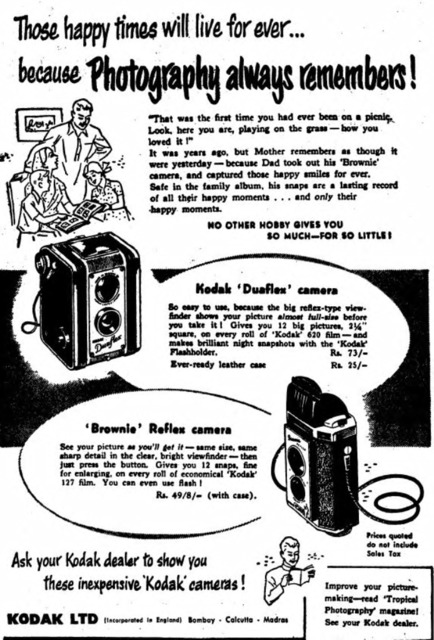 Fig. 12. Kodak Ltd., “Those happy times will live forever,” The Times of India, 7 January 1952, pg. 5, courtesy of Eastman Kodak Company.
Fig. 12. Kodak Ltd., “Those happy times will live forever,” The Times of India, 7 January 1952, pg. 5, courtesy of Eastman Kodak Company.The 1950s Kodak ads in the Times drew on discourses of the “middle class,” domesticity, family, and everyday life in India — complex and multifarious concepts that were far from concrete but had broad-ranging cultural and social relevance in Indian society nonetheless.[73] Kodak illustrations of Indian nuclear families, often a father, a mother, and a child, populated the pages of the Times. An ad from 1952 shows one of Kodak’s early attempts to depict the Indian nuclear family at home (figure. 12). In a simple line drawing, a father wearing a long, collared kurta leans over his wife, seated, who wears a polka-dotted sari pulled up over her hair, and they are flanked by two children. Together they are looking at a photo album. The narrative explains, “[The picnic] was years ago, but Mother remembers as though it were yesterday — because Dad took out his ‘Brownie’ camera, and captured those happy smiles for ever.” It continues: “Safe in the family album, his snaps are a lasting record of all their happy moments . . . and only their happy moments.” Other than a couple of slightly altered cultural codes (his shirt, her sari), the people bear a striking resemblance to a Western nuclear family, though the ad captures a sense of modernity to which many Indian consumers aspired.[74]
This ad, then, shows Kodak’s early visual adaptations and also reveals how the company began to recontextualize the cultural practices of photography for local consumers by describing the camera as a father’s hobby and the snapshot as a mother’s mnemonic aid as she compiles albums and tells the family’s stories. The emphasis on only happy moments may be an attempt to distance the brand from the tumultuous experience that many families had recently undergone during Partition, a trauma that scholars are only now coming to understand, and may have been a prescription for the type of photos meant to appear in the family album. Like many of the ads that were produced for the brand in Western publications, this one inscribes the Kodak with familial meanings and identifies its role in leisure activities and daily family life. It also contains a visual representation of a family activity on which the brand depended — the act of looking through photos.
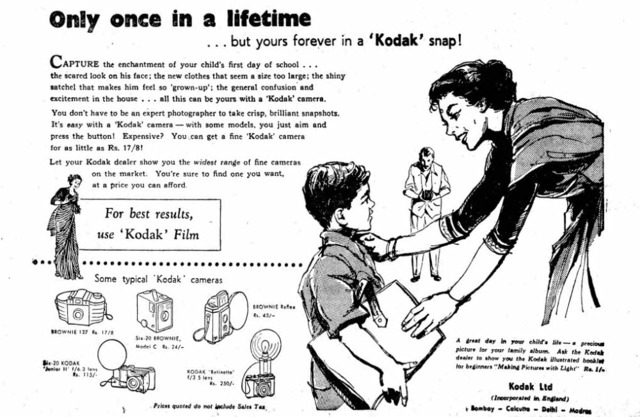 Fig. 13. Kodak Ltd., “Only once in a lifetime,” The Times of India, 27 November 1955, pg. 13, courtesy of Eastman Kodak Company.
Fig. 13. Kodak Ltd., “Only once in a lifetime,” The Times of India, 27 November 1955, pg. 13, courtesy of Eastman Kodak Company.In the 1950s, the “father-photographer” emerged as an important subject in many of the ads, arguably playing as significant a role as did the Kodak Girl of the 1920s and shifting the brand’s focus from ideas of freedom and femininity to perceptions of paternal, domestic responsibility. The Kodak Girl, a marketing icon not altogether abolished during this time, now takes on the appearance of a beautiful Indian woman who wears a striped sari and holds, or gestures to, a camera.[75] (figure 13). The ads center on the “father-photographer” who uses the camera to capture his family at home. Whereas the 1952 ad copy mentions a time when the father took out his Brownie camera, many of the ads that follow show him in the process of composing snapshots, thereby highlighting his role as family photographer, as well as identifying important moments to memorialize. For example, in an ad from 1955, the illustration is of a mother as she prepares her son for his first day of school. She wears a sari and has a bindi on her forehead, which denotes her status as a married woman.[76] In the distance, the father wears a buttoned-up shirt and pleated trousers and takes a snapshot with the Brownie camera that hangs around his neck by a strap. The copy reads, “Capture the enchantment of your child’s first day of school” — a trope arguably invented by Kodak — and adds that such a photograph would be a “precious picture for your family album.” Here, the ad suggests that it is the father’s role to catch these fleeting moments.
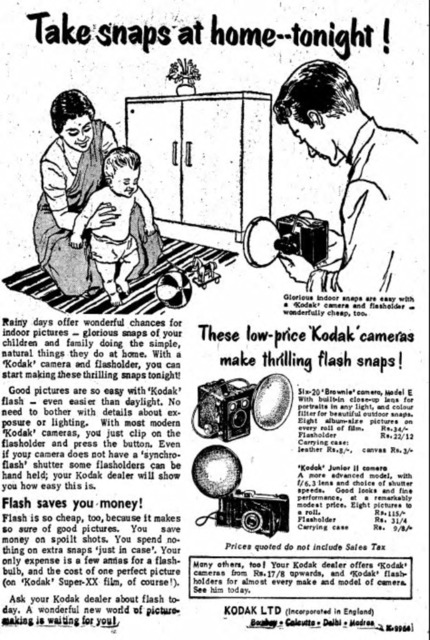 Fig. 14. Kodak Ltd., “Take snaps at home—tonight!” The Times of India, 4 July 1954, pg. 10, courtesy of Eastman Kodak Company.
Fig. 14. Kodak Ltd., “Take snaps at home—tonight!” The Times of India, 4 July 1954, pg. 10, courtesy of Eastman Kodak Company.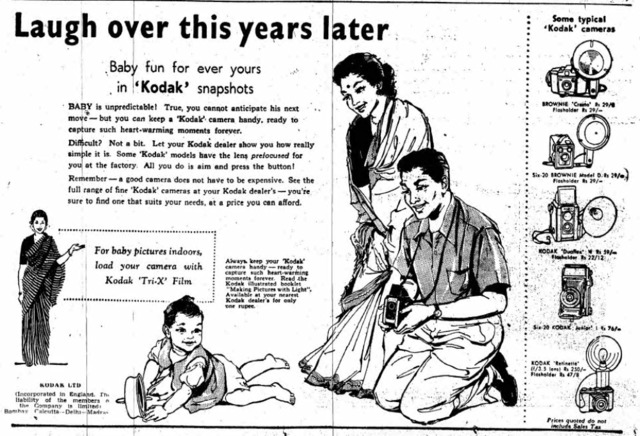 Fig. 15. Kodak Ltd., “Laugh over this years later,” The Times of India, 27 May 1956, pg. 7, courtesy of Eastman Kodak Company.
Fig. 15. Kodak Ltd., “Laugh over this years later,” The Times of India, 27 May 1956, pg. 7, courtesy of Eastman Kodak Company.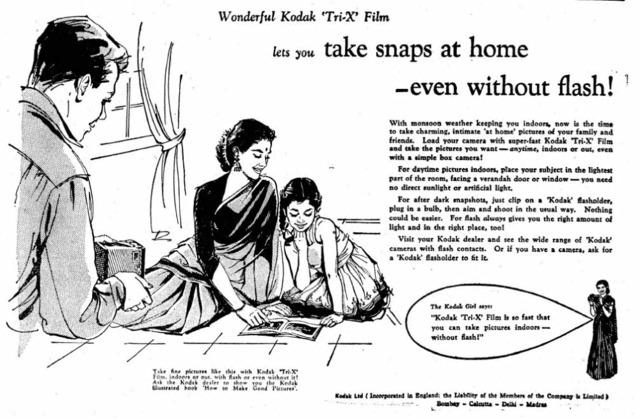 Fig. 16. Kodak Ltd., “Wonderful Kodak ‘Tri-X’ Film,” The Times of India, 8 July 1956, pg. 3, courtesy of Eastman Kodak Company.
Fig. 16. Kodak Ltd., “Wonderful Kodak ‘Tri-X’ Film,” The Times of India, 8 July 1956, pg. 3, courtesy of Eastman Kodak Company.More ads were produced that depict fathers taking photos to indicate the types of moments to be remembered, such as three that marketed Kodak’s ability to take quality photographs indoors. In the first, from 1954, a father uses a Brownie camera with a flash to take a picture of a mother kneeling on a mat as she happily holds her baby up onto his feet (figure 14). The interior decor is modern — a striped mat, a rectangular cupboard, and a vase with flowers. The copy describes potential photographs that could be taken as “glorious snaps of your children and family doing the simple, natural things they do at home.” In the second ad, a father kneels on the ground to take a photo of “unpredictable” baby, who plays with a pot and crawls on the floor (figure. 15). Here the mother, again with a sari and a bindi, stands lovingly looking over the father’s shoulder to observe the scene. In the third, a father takes a photograph of his wife and daughter, who sit as they look at a book (figure 16). The copy explains that it is monsoon season, and a perfect time to take “charming, intimate ‘at home’ pictures of your family.” It is interesting that by the mid-1950s, the visual trope of an Indian woman with long black hair tied in a bun, long eyelashes, and almond-shaped eyes had taken hold. To embed Kodak into everyday Indian domestic life, the company used illustrations to establish the role of father-photographer, always in relation to the nuclear family, and to make a place for snapshot photography in existing cultural institutions and aspects of daily life. The 1950s ads drew on Kodak’s discursive strategies of evoking nostalgia and childhood first developed in its Western ads,[77] but also forged a place for the use of Kodak cameras during everyday pastimes; at local events (such as sitar concerts);[78] at traditional holidays (such as Diwali);[79] and even during dramatic weather (such as monsoon season).
The marketing strategies of the 1950s show how the Kodak brand was transposed, adapted to, and associated with an Indian familial context. Although it is difficult to ascertain the effectiveness of the ads on local consumption patterns, there is evidence that the company’s narrative of family photography fit into a widespread, growing popularity of amateur photography in Indian society in articles such as “Photo-Mania” (1951) and “Cameromania” (1954).[80] The former describes “photo-mania” as an “awkward disease” that strikes children and middle-aged people. In the article, the writer mentions the nuisance of a family photographer on a seaside holiday who finds “a story in every breeze and a picture in every wave.” He describes the amateur family photographer in almost villainous terms, cheekily describing “photo-mania” as a “dangerous” affliction and photography gear as “abominations.” The article outlines the toll that amateur photography takes on the household in terms of the space, budget, and even relationships, as one needs to put up with incessant posing, picture-taking, and “foto-fiendish conversation.” In “Cameromania,” P. R. Shinde describes a frustrated father who has presented his son with a camera and is now forced to pose with the family for photographs that ultimately fail to turn out. This article addresses with great impatience the need to put up with the photographer who is a modern art enthusiast — who can find “beauty in a dustbin” — or a “collectomaniac” — who must be avoided if one does not want to listen to his “ceaseless talk.” Neither embraces family or amateur photography wholeheartedly, but both speak to a wider cultural practice, if not obsession with, snapshot photography in India and a broader photographic landscape in which Kodak and the family snapshot had become firmly embedded.
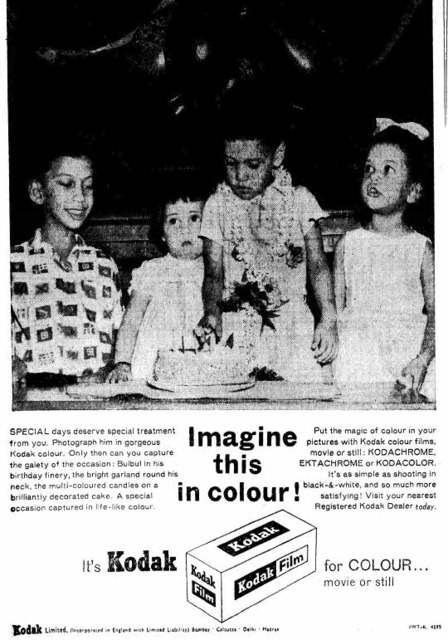 Fig. 17. Kodak Ltd. and J. Walter Thompson, “Imagine this in colour,” The Times of India, 24 February 1963, pg. 7, courtesy of Eastman Kodak Company and J. Walter Thompson.
Fig. 17. Kodak Ltd. and J. Walter Thompson, “Imagine this in colour,” The Times of India, 24 February 1963, pg. 7, courtesy of Eastman Kodak Company and J. Walter Thompson.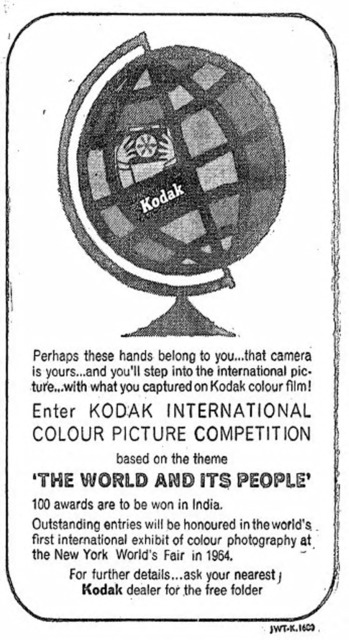 Fig. 18. Kodak Ltd. and J. Walter Thompson, “The World and its People,” The Times of India, 1 September 1963, pg. 11, courtesy of Eastman Kodak Company and J. Walter Thompson.
Fig. 18. Kodak Ltd. and J. Walter Thompson, “The World and its People,” The Times of India, 1 September 1963, pg. 11, courtesy of Eastman Kodak Company and J. Walter Thompson.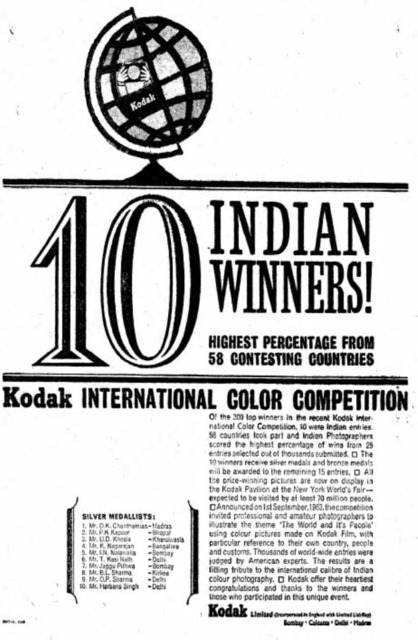 Fig. 19. Kodak Ltd. and J. Walter Thompson, “10 Indian Winners,” The Times of India, 15 May 1964, pg. 11, courtesy of Eastman Kodak Company and J. Walter Thompson.
Fig. 19. Kodak Ltd. and J. Walter Thompson, “10 Indian Winners,” The Times of India, 15 May 1964, pg. 11, courtesy of Eastman Kodak Company and J. Walter Thompson.Whereas the 1950s ads looked inward, focusing on Indian middle-class domesticity, the decade that followed sought to use Kodak products to project images of India and its people produced by Indian photographers on global platforms in the form of competitions. Of course, discourse of family photography in Kodak ads continued in the early 1960s, particularly with the marketing of color film, and the brand began to use photographs of Indian families, rather than illustrations, in its Times ads. For example, the ads contained photographs of kids at a birthday party — a familiar Kodak trope — and exhorted readers: “Imagine this in colour!”[81] (figure 17). However, what appears to set apart the early 1960s is the change in direction to more global, and participatory, approaches to advertising in the wake of Edward Steichen’s tour of the Family of Man exhibition (1956) and the Images of India photography competition and exhibition organized by the Bombay Photography Association (1960).[82] Several Kodak ads of this time encouraged Indian photographers to enter worldwide contests hosted by the company — such as 1963’s “The World and Its People” — which would culminate in an exhibition at New York’s World Fair for an audience of more than “70 million people” (figure 18). Later, ads for Kodak’s international contests listed the names of the Indian photographers who won and highlighted India’s national achievement, such as its “highest percentage of wins” out of the fifty-eight participating countries (figure 19). Here, the shift toward a universal discourse and the idea of cultural competitions on the world stage reflect the impact of increased globalization and the intensification of Cold War ideologies, as well as the Western use of photography in transnational cultural diplomacy within a Cold War context.[83]
Conclusion: Turning a New Page (post-1964)
By locating representations of Indian nuclear families, domesticity, and quotidian doings in a survey of Kodak ads, this article has demonstrated that the company had firmly entrenched its association with “snapshots in a family album” for Indian consumers in the 1950s by incorporating its product in local cultural institutions and practices and by creating new subjects, such as the “father-photographer.” In efforts to forge the brand’s place in India’s daily life, Kodak took up in its ads late- and postcolonial discourses of nationalism, emerging concepts of the “middle class” and the “nuclear family,” family-centered consumption patterns, and a growing domestic economy.[84] This research helps to contextualize the 1969 “Snapshots in a Family Album” ad discussed at the start of this essay (figure 1), which made assertions about mainstream ideas of snapshot photography in relation to Indian family life and hinted at the beginning of a new phase of Kodak marketing that sought to appeal to professionals and leaders of industry.
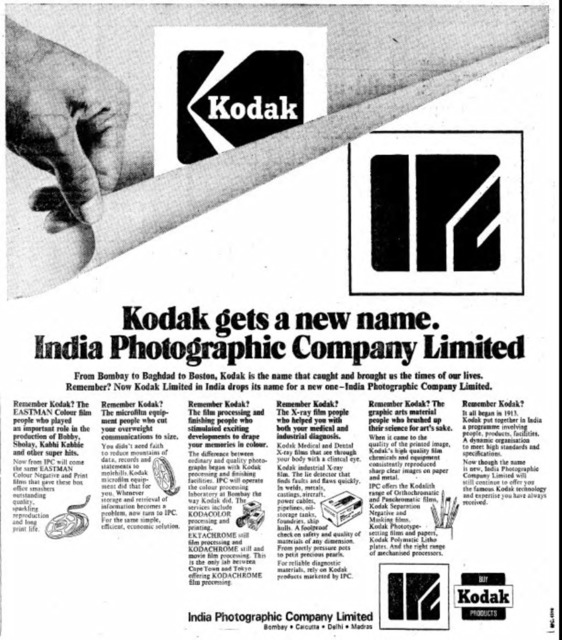 Fig. 20. India Photographic Company Ltd./Kodak Ltd., “Kodak gets a new name,” The Times of India, 11 June 1979, pg. 10, courtesy of Eastman Kodak Company.
Fig. 20. India Photographic Company Ltd./Kodak Ltd., “Kodak gets a new name,” The Times of India, 11 June 1979, pg. 10, courtesy of Eastman Kodak Company.As noted, by the mid- to late 1960s, Kodak appeared to move away from presenting itself as a brand associated strictly with the widespread cultural practice of family photography and reasserted its use in industries beyond the confines of the home. This move occurred during a time of severe economic crises, increased socialistic control, and protectionism.[85] For example, the nationalization of industries and banks, which involved government seizure of assets and control, had been taking place in India in the late 1960s under Prime Minister Indira Gandhi.[86] Whereas the “Snapshots in a Family album” ad alludes to a “turning of the page,” Kodak ads in the late 1970s explicitly show the page turning, as in one published on June 11, 1979 (figure 20).[87] Here, a hand turns a page to reveal a logo for India Photographic Company (IPC) Ltd., and there is this announcement: “Kodak gets a new name.” As this ad shows, the late 1970s marks a period during which Kodak/IPC embarked on a wide-ranging marketing campaign that described what it called the “Indianisation” of the company,[88] although the ads for IPC promise that the company’s expertise, products, and locations would remain unchanged. In addition to a new name and a new logo, in some ads of this era, Kodak/IPC printed staff photos representing Indian employees, contained endorsements from prominent Indian figures, and predicted opportunities for Indian investors to buy shares in the company.[89] Unlike nationalization, it appears that Kodak’s transformation was largely a rebranding with some new policies and restructuring based on the participation of the Indian public, though more research is needed to delve into this chapter in Kodak’s history. Nonetheless, this new marketing campaign reflected the impact of even greater pressure on foreign companies not only to appeal to Indian consumers, but also to become public corporations.[90] A far cry from the colonialist ads of the 1920s and a move away from the 1950s ads that centered on everyday Indian domesticity and families, the ads of the 1970s show Kodak effecting wide-scale corporate rebranding and restructuring, illustrating the significant impact of increased state control on the multinational photography company and how it once again sought to reinvent itself to readers of the Times.
Jennifer Orpana is an assistant curator at the Royal Ontario Museum, where she focuses on The Family Camera Network project, a public archive of family photographs and oral histories based on the theme of migration. Her writing has been published in RACAR and Fuse Magazine, and she coedited a Photography & Culture special issue on family photography with Sarah Parsons (July 2017).
George Eastman founded the Eastman Kodak Company in 1892. See “Eastman Kodak Company,” Encyclopedia of Twentieth-Century Photography, vol. 1 (New York: Routledge, 2006): 425.

Kodak advertised Verichrome Pan (black-and-white film) and Kodacolor (color) film in The Times of India, and the ads listed urban centers where Kodak dealers were located. Kodak advertised the availability of its color films in India in The Times of India as early as the 1960s, though this product may have been scarce. See, for example, “It’s Kodak for Colour,” The Times of India (31 July 1960, p. 3); “Capture colour with Kodak colour films,” The Times of India (7 September 1962, p. 3); or “What is a rose without colour?” The Times of India (24 March 1963, p. 7).

Kodak did advertise the use of its products in science, technology, and medicine prior to this ad, particularly its use for x-rays; however, as this ad suggests, its brand identity centered primarily on the use of the snapshot camera to capture family memories and daily life.

See, for example, Gary D. Sampson, “The Success of Samuel Bourne in India,” History of Photography 16, 4 (Winter 1992): 336-347; Christopher Pinney, Camera Indica: The Social Life of Indian Photographs (London & Chicago: Reaktion Books Ltd. & University of Chicago Press, 1997); Christopher Pinney, The Coming of Photography in India (London: The British Library, 2008);
James R. Ryan, Picturing Empire: Photography and the Visualization of the British Empire (Chicago: The University of Chicago Press, 1997); Eleanor M. Hight and Gary D. Sampson, eds. Colonialist Photography: Imag(in)ing Race and Place (New York: Routledge, 2002); Zahid Chaudhary, “Phantasmagoric Aesthetics: Colonial Violence and the Management of Perception,” in Cultural Critique 59 (Winter 2005): 63-119; Zahid Chaudhary, Afterimage of Empire: Photography in Nineteenth-Century India (Minneapolis: University of Minnesota Press, 2012); Vidya Dehejia, ed., “Fixing a Shadow,” in India Through the Lens: Photography 1840-1911 (Mandala Publishing, 2006); Xavier Guégan, “Visualizing Alienation: Symbolism and Duality in Samuel Bourne’s Photographs of British India,” in Visual Culture in Britain (2011): 349-369; Sandeep Banerjee, “‘Not Altogether Unpicturesque’: Samuel Bourne and the Landscaping of the Victorian Himalaya,” in Victorian Literature and Culture 9, 42 (2014): 351-368; Sean Willcock, “Aesthetic Bodies: Posing on Sites of Violence in India, 1857-1900,” in History of Photography 39, 2 (May 2015): 142-159; and Jodi Throckmorton, et al., Postdate: Photography and Inherited History in India (California: San Jose Museum of Art with University of California Press, 2015).

Chaudhary, “Phantasmagoric Aesthetics: Colonial Violence and the Management of Perception,” 74.

As the next section will show, I am indebted to Kamal A. Munir and Nelson Phillips, “The Birth of the ‘Kodak Moment’: Institutional Entrepreneurship and the Adoption of New Technologies,” in Organizational Studies 26, 11 (2005): 1665–87.

Importantly, the Kodak ads explored here do not do justice to the complexity of the concept of the middle class in India, nor do they reflect the history and diversity of family formations in the subcontinent. Many scholars have discussed a “middle class” in India and its use as a discursive concept, particularly in the twentieth century. In addition, several scholars have examined the history of diverse family formations in India. See, for example, Douglas E. Haynes, “Creating the Consumer? Advertising, Capitalism, and the Middle Class in Urban Western India, 1914-1940,” in Towards a History of Consumption in South Asia, edited by Haynes et al., 184-223 (London: Oxford University Press, 2010): 206–207; Abigail McGowan, “Consuming Families: Negotiating Women’s Shopping in Early Twentieth Century Western India,” in Towards a History of Consumption in South Asia, edited by Haynes et al., 154-183 (London: Oxford University Press, 2010): 159; Prashant Kidambi, “Consumption, Domestic Economy, and the Idea of the ‘Middle Class’ in Late Colonial Bombay,” in Towards a History of Consumption in South Asia, edited by Haynes et al., 109-135 (London: Oxford University Press, 2010): 108–112; Indrani Chatterjee, Unfamiliar Relations: Family and History in South Asia (Rutgers University Press, 2004); Surinder S. Jodhka & Aseem Prakash, The Indian Middle Class (New Delhi: Oxford University Press, 2016); and Sanjay Joshi, “India’s Middle Class,” in Oxford Research Encyclopedia: Asian History. April 2017, http://asianhistory.oxfordre.com/view/10.1093/acrefore/9780190277727.001.0001/acrefore-9780190277727-e-179 (accessed 1 August 2018).

It should be noted that there were other contemporary roll films and cameras being advertised, for such brands as Agfa India Ltd., Allied Photographics Ltd., and Ilford Ltd., in the Times, but it appears that none used illustrations of Indian families or middle-class domestic settings to the same degree as did Kodak in the 1950s. For example, 1930s Selochrome ads for Ilford demonstrate the use of colonial and “glocalized” narratives (a term used in Bhatia and Bhargava, 2014), a linguistic strategy that uses a hybrid of a local language and English by incorporating local words such as sahib, chhota, wallah, and pukka into their English-language copy. An early survey of Agfa ads in the Times finds that the company marketed its products highlighting themes of modernism, art, tourism, trade, nationalism, and politics. Each of these companies’ ads is deserving of further investigation to understand unique strategies and trajectories, and this is not to mention the larger cultural landscape within which ads would have been produced in other publications and media, among them vernacular media. See Tej K. Bhatia and Mukesh Bhargava, “‘America’ in Indian Advertising: Change and Impact,” in Comparative American Studies 12, 1-2 (June 2014): 71-83.

Dewan notes a paucity of scholarly work on vernacular family photography in South Asia, due in part to the lack of archives of South Asian family photographs that preserve the “practice of family photography.” See Deepali Dewan, Sukanya Baskar, and Rahab Allana, “Collecting Family Photographs: An Interview with Deepali Dewan.” PIX. 31 March 2018, http://www.enterpix.in/pix-post/collecting-family-photographs/ (accessed 2 June 2018).

See, for example, Judith Mara Gutman, Through Indian Eyes: 19th- and Early-20th-Century Photography from India (New York: Oxford University Press with the International Center of Photography, 1982); Pinney (1997; 2008); Hight and Sampson (2002); Dehejia (2006); Tasneem Zakaria Mehta, et al., The Artful Pose: Early Studio Photography in Mumbai c. 1855–1940 (Ahmedabad and London: Mapin Publishing Pvt. Ltd. and The Alkazi Collection of Photography, 2010); Chaudhary (2012); Ludger Derenthal, Raffael Dedo Gadebusch, and Katrin Specht, The Colonial Eye: Early Portrait Photography in India (Berlin: Staatliche Museen zu Berlin, Koehler & Amelang, 2012); and Deepali Dewan and Deborah Hutton, Raja Deen Dayal: Artist-Photographer in 19th-Century India (Ahmedabad and London: Mapin Publishing Pvt. Ltd. and The Alkazi Collection of Photography, 2013).

Munir and Phillips, “The Birth of the ‘Kodak Moment,’” 1665–87.

Christina Lubinski offers a historical study of German multinational businesses in pre-independence India, which is useful in terms of understanding the context of challenges and opportunities faced by other transnational companies, such as Kodak. See “Liability of Foreignness in Historical Context: German Business in Preindependence India (1880–1940),” in Enterprise & Society 15, 4 (2014): 722–58.

David Arnold, Everyday Technology: Machines and the Making of India’s Modernity (Chicago and London: The University of Chicago Press, 2013).

See, for example, Arnold, Everyday Technology, 56, 72, 108, and 124.

See, for example, Nancy Martha West, Photography: A Critical Introduction, edited by Liz Wells (New York: Routledge, 2015): 159–63.

For a comprehensive overview of this research, see Douglas E. Haynes, “Advertising and the History of South Asia,” in History Compass 13, 8 (2015): 361–74. See also Haynes, et al (2010); Deepali Dewan, ed. Bollywood Cinema Showcards: Indian Film Art from the 1950s to the 1980s (Toronto: Royal Ontario Museum, 2011); William Mazzarella, Shovelling Smoke: Advertising and Globalization in Contemporary India (Durham and London: Duke University Press, 2003); Abigail McGowan, “Domestic Modern: Redecorating Homes in Bombay in the 1930s,” in Journal of the Society of Architectural Historians 75, 4 (Dec. 2016): 424–46; William Mazzarella, “‘Very Bombay’: Contending with the Global in an Indian Advertising Agency,” in Cultural Anthropology 18, 1 (February 2003): 33–71.

See, for example, Haynes, “Advertising and the History of South Asia,” 361–74; Kidambi, “Consumption, Domestic Economy, and the Idea of the ‘Middle Class’ in Late Colonial Bombay,” 109–135; Haynes, “Creating the Consumer?” 184–223; McGowan, “Consuming Families,” 154–83; and McGowan, “Domestic Modern,” 424–46.

Barney Henderson, “Indian Independence Day,” in The Telegraph, 15 August 2017, https://www.telegraph.co.uk/news/2017/08/15/indian-independence-day-everything-need-know-partition-india/ (accessed 10 June 2018).

“Timeline: Key dates in history of independent India,” Reuters, 9 August 2007, https://uk.reuters.com/article/timeline-key-dates-in-history-of-indepen-idUKZWE94271220070809 (accessed 10 June 2018).

Ibid. See also Henderson (2018); Bipan Chandra, et al., India’s Struggle for Independence 1857–1947 (New York: Penguin Books, 2012); and Arnold, Everyday Technology, 95–100.

Arnold, Everyday Technology, 95–120; 107; McGowan, “Consuming Families,” 157–60; Chandra, et al. (2012); Haynes, et al. (2010); and Arvind Panagariya, “India’s Trade Reform,” in India Policy Forum 2004, https://www.brookings.edu/wp-content/uploads/2016/07/2004_panagariya.pdf (accessed 8 June 2014): 1–68.

Kodak’s presence in other English-language and vernacular papers is beyond the scope of this article, but it would be a rich subject for further study.

I am thankful to ProQuest and The Times of India group, which in 2010 collaborated to make this archive accessible. See “ProQuest and The Times of India Partnership Significantly Expands International Content in Historical Archive,” in ProQuest, 8 March 2010, https://www.proquest.com/about/news/2010/ProQuest-and-The-Times-of-India-Partnership.html (accessed 1 August 2018).

“The Times of India,” Encyclopaedia Britannica, 2018, https://www.britannica.com/topic/The-Times-of-India (accessed 10 June 2018).

The Times of India, 2018, https://timesofindia.indiatimes.com/ (accessed 8 June 2018).

Haynes and McGowan stress that a study of advertising in India “does not directly reflect what people bought.” See Haynes, et al., Towards a History of Consumption, 13.

See Pinney (1997, 2008); Ryan (1997); Hight and Sampson (2002); Chaudhary (2005; 2012); Guégan (2011); Banerjee (2014); and Willcock (2015).

See, for example, Pinney, Camera Indica, 17–34; Chaudhary, Afterimage of Empire, 3–4; Chaudhary, “Phantasmagoric Aesthetics,” 76–77; Ryan, Picturing Empire, 45–72; Willcock, “Aesthetic Bodies,” 142–59; Guégan, “Visualizing Alienation,” 349–56; Sampson, “Unmasking the Colonial Picturesque,” in Colonialist Photography, 84–102; and Banerjee, “‘Not Altogether Unpicturesque,’” 351–67.

This strategy was characteristic of the time. See Haynes, “Creating the Consumer?” 188.

Dehejia, “Fixing a Shadow,” 17. For more on the Peninsular & Oriental Steam Navigation Company, see “P & O Steam Navigation Company,” in P & O Heritage, 2018, http://www.poheritage.com/our-history/company-guides/peninsular-and-oriental-steam-navigation-company (accessed 2 June 2018).

Kodak Canada Ltd. opened in Toronto in 1899 and Kodak Australia was founded in 1908. See “Eastman Kodak Company,” 425; “Company Overview of Kodak Limited,” Bloomberg, 2018, https://www.bloomberg.com/research/stocks/private/snapshot.asp?privcapid=4939911 (accessed 8 June 2018); and “Kodak in Toronto, 1899–2005: A Century of Traces,” in Ryerson Archives & Special Collections, 5 January 2015, https://library.ryerson.ca/asc/2015/01/kodak-in-toronto-1899-2005-a-century-of-traces/ (accessed 1 August 2018); Angeletta Leggio, “A history of Australia’s Kodak manufacturing plant,” AICCM Symposium, 2006, https://aiccm.org.au/sites/default/files/docs/BPG2006/AICCM_B&P2006_Leggio_p147-158.pdf (accessed 1 August 2018).

F.J.M & Anastigmat, “Photography in India,” in Photography: The Journal of the Amateur, the Profession, and the Trade IX (London: Iliffe & Son, 1897): 319–20. For the challenges noted, see Dehejia, “Fixing a Shadow,” 17.

The history of how the ads in South Asia were produced, where, and by whom needs to be investigated further. George Eastman and later Lewis Bunnell Jones were responsible for Kodak’s American advertising. By 1980, J. W. Thompson, a leading American transnational ad agency (TNAA), listed Kodak as one of its clients. Anderson has noted that TNAAs most often establish themselves in locations where they already have clients. J. W. Thompson set up offices in London in 1899, in Mumbai in 1929, and in New Delhi in 1944, and had an associate, Hindustan Thompson, in Mumbai by the 1970s. From the ads in the Times, we know that Kodak Ltd. dealers and the Kodak House were established in India by this time, so it is quite possible that the ads from the 1920s onward were produced for Kodak by J. W. Thompson/Hindustan Thompson. See West, Kodak and the Lens of Nostalgia, 19–35; Michael H. Anderson, Madison Avenue in Asia: Politics and Transnational Advertising (London and Toronto: Associated University Press, 1984): 91, 106, and 126; and “J. Walter Thompson’s History of Advertising,” 2018, https://www.jwt.com/history/ (accessed 2 June 2018).

See, for example, West, Kodak and the Lens of Nostalgia, 19–35; and Munir and Phillips, “The Birth of the ‘Kodak Moment,’” 1665-1687.

This information draws on the locations listed in the various Kodak ads between the 1920s and the 1970s in the Times. Nineteen thirteen is identified in a later ad for the India Photographic Company Limited (formerly Kodak Ltd.) as the year during which Kodak established a program of “people, products, and facilities” in India. See, for example, figure 20.

West, Kodak and the Lens of Nostalgia, 53; Munir and Phillips, “The Birth of the ‘Kodak Moment,’” 1676.

For an extensive exploration of the American Kodak Girl, see West, Kodak and the Lens of Nostalgia, 109–135.

Ibid., 131. More research is necessary to determine if these ads were also printed in British newspapers and journals, to answer the question of whether these early ads merely transposed British ones to this different context. It is possible that these ads were printed in British newspapers of the time to reach consumers before they embarked on their journeys.

When not taking in the Indian landscape, the Kodak Girl and her companions can be seen in other 1920s Times ads playing sports and enjoying other leisure activities.

Gary D. Sampson examines Bourne’s photography to outline the qualities of the colonial picturesque and notes how the presence of women in Indian landscape photography helped to depoliticize and neutralize the conflicted social and political terrain in India. See Sampson, “Unmasking the Colonial Picturesque,” 90, 98–102.

Ryan, Picturing Empire, 50–51. Sampson mentions the interest Western viewers had in Muhgal architecture in “Unmasking the Colonial Picturesque,” 91.

Sampson demonstrates how the picturesque functions in the photography of Samuel Bourne in “Unmasking the Colonial Picturesque,” 84. See also Hight and Sampson (2004), Guégan (2011), and Willcock (2015).

Matkas are clay pots used in Indian kitchens, described as “traditional refrigerators” because their design enables them to keep water cool. See “Matka – the earthen pot,” Gaatha: A Tale of Crafts, 8 May 2013, http://gaatha.com/matka-the-earthen-pot/ (accessed 6 June 2018).

Sampson discusses the disavowal of social conflict in the picturesque in “Unmasking the Colonial Picturesque,” 90. For work on power relations associated with photographic events and encounters, see Ariella Azoulay, “Photography: The ontological question,” 2011, http://mafteakh.tau.ac.il/en/wp-content/uploads/2011/01/Photography.pdf (accessed 1 August 2018); and Ariella Azoulay, The Civil Contract of Photography (New York: Zone Books, 2008).

For discussions of familiarity, domesticity, and motherhood in colonialist picturesque photography, see Guégan, “Visualizing Alienation,” 350; Hight and Sampson, Colonialist Photography, 5; and Sampson, “Unmasking the Colonialist Picturesque,” 98–99.

Such ads can be found in the Times on Dec. 21, 1942; Jan. 2, 1943; Sept. 17, 1945; and July 7, 1945.

Haynes outlines this historical context in “Creating the Consumer?” 216–17.

This was a hope expressed by other advertisers in English-language papers as well — Haynes notes that one cloth manufacturer ran an ad that exclaimed boldly: “BUY WHAT YOU PLEASE!” See Haynes, “Creating the Consumer?” 217.

Kodak Ltd., “Make the most of your pictures,” The Times of India, 6 February 1947, 3.

Tirthankar Roy, The Economic History of India, 1857–1947, 3rd edition (New Delhi: Oxford University Press, 2000): 287–89, 292–93.

Frank Moraes, “Jawaharlal Nehru: Prime Minister of India,” Encyclopaedia Britannica, 6 July 2018, https://www.britannica.com/biography/Jawaharlal-Nehru (accessed 1 August 2018).

Lubinski summarizes some of the challenges faced by multinational businesses in “Liability of Foreignness,” 723.

Joshi, “India’s Middle Class,” http://asianhistory.oxfordre.com/view/10.1093/acrefore/9780190277727.001.0001/acrefore-9780190277727-e-179 (accessed 1 August 2018).

Ibid. Joshi writes, “With decolonization, a middle-class leadership eventually replaced the British ruling class in India.”

According to Haynes, this expectation was happening as early as the 1930s. See “Advertising and the History of South Asia,” 370.

For Kodak’s history of asking staff to submit marketing ideas, see West, Kodak and the Lens of Nostalgia, 25. For a reflection on Kodak’s hierarchical hiring of Indian, Anglo-Indian, and British employees in 1950s Pakistan as well as a staff photograph, see Leslie Morgan, “Kodak Migrant Moments,” in Social Alternatives 29, 3 (2010): 14–19.

Much research has been conducted on middle-class consumption, showing an increase in family-centered spending, the role of gender in consumption patterns, and the rise of a “domestic economy,” which saw local aspirations for, as well as appropriations of, modern decor in Indian households. There has also been work to show the increasing visual presence of Indian nuclear families in early- to mid-century advertisements, despite the wide-ranging types of family formations and identities that existed during this time. Of course, conceptions of the middle class were not new to this period, as Joshi’s discussion of the colonial middle class helps to illustrate. Likewise, the scholar Prashant Kidambi writes that in the decades leading up to independence (1920s to 1940s), urban, middle-class identities started to develop in Indian cities and that after WWII “the economic context of everyday life became increasingly central to public discourse about the middle class” in Mumbai, a city in which both Kodak Ltd. and transnational ad agencies such as J. W. Thompson had a presence. By the 1950s, Kodak had definitely taken up and reinforced concepts of everyday life experienced by Western middle-class, nuclear families in the United States, but here we see these marketing strategies adapted to an Indian familial context. See, for example, Haynes, et al. (2010); Kidambi, “Consumption, Domestic Economy, and the Idea of the ‘Middle Class’ in Late Colonial Bombay,” 109; Anderson, Madison Avenue in Asia, 126; Joshi (2017); and McGowan (2016).

For more on the relationship between the Indian middle class and ideas of modernity, see Joshi (2017).

This is not to oversimplify this new characterization of the Kodak Girl. More studies are necessary to consider how this shift reflects complex conceptions of gender in relation to snapshot photography in India and to enrich the history of this icon considering her transnational identities.

This article highlights the appearance of a “father-photographer,” but the concepts of femininity and motherhood in ads produced during the nationalist period, such as this one, in relation to other images of women that circulated at this time, deserve further attention.

See, for example, Kodak Ltd., “The melody lingers on . . .,” The Times of India (12 February 1956, p. 7).

See, for example, Kodak Ltd., “The gift that goes on giving,” The Times of India (17 October 1954, p. 3).

Tambimuttu, “Photo-Mania,” The Times of India (25 November 1951, p. 8); P. R. Shinde, “Cameromania,” The Times of India (21 March 1954, p. 7).

Kodak Ltd., “Imagine this in colour,” The Times of India (24 February 1963, p. 7).

Atreeyee Gupta briefly discusses the history of these two exhibitions and contextualizes them as significant moments in the transcultural history of photography in India. See Gupta, “Belatedness and Simultaneity,” 31–33; and M. Desai, “‘Family of Man’ Exhibition,” in The Times of India (19 June 1956, p. 3).

There is much more that can be done to further contextualize these Kodak competitions and ads within a global Cold War context. For a discussion of how questions of visuality are pivotal to understanding the history of the global Cold War, see Sarah Bassnett, Andrea Noble, and Thy Phu, eds. Visual Studies: Cold War visual alliances 30, 2 (2015): 119–122. See also Eric Sandeen, Picturing an Exhibition: The Family of Man and 1950s America (Albuquerque: University of New Mexico Press, 1995); and Eric Sandeen, “The Family of Man in Guatemala,” Visual Studies 30, 2 (2015): 120–130.

This is informed by considerable scholarship on the history of consumption in India. See, for example, Kidambi, “Consumption, Domestic Economy, and the Idea of the ‘Middle Class’ in Late Colonial Bombay,” 109-135; Haynes, “Creating the Consumer?” 184–223; McGowan, “Consuming Families,” 154–83; and McGowan, “Domestic Modern,” 424–46.

For the history of nationalization of banks and industry, see Roy, The Economic History of India, 299–300; and Anderson, Madison Avenue in Asia, 126.

Kodak Ltd./India Photographic Company Ltd., “Kodak gets a new name.” The Times of India (11 June 1979, p. 10).

See, for example, Kodak Ltd./India Photographic Company Ltd., “The experts you knew and respected in Kodak will now serve you in IPC,” in Economic and Political Weekly (18 August 1979, p. 1418); and Anderson, Madison Avenue in Asia, 126.


